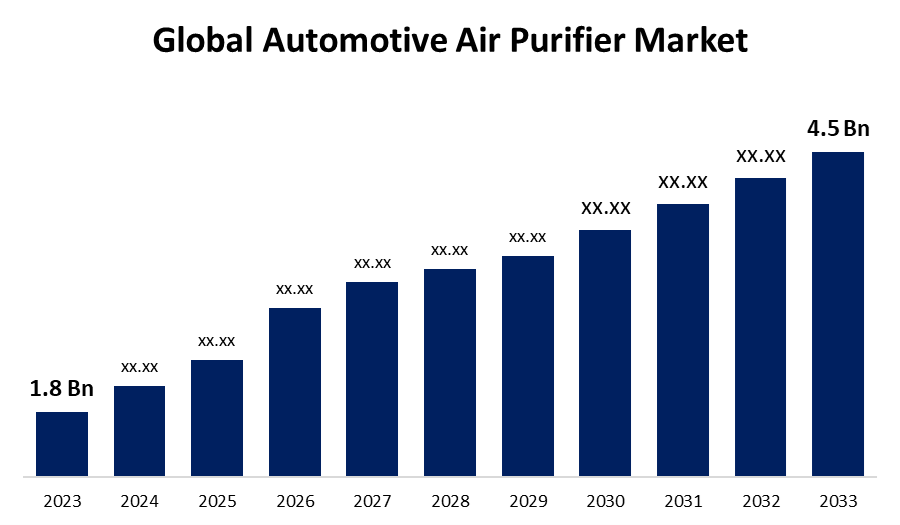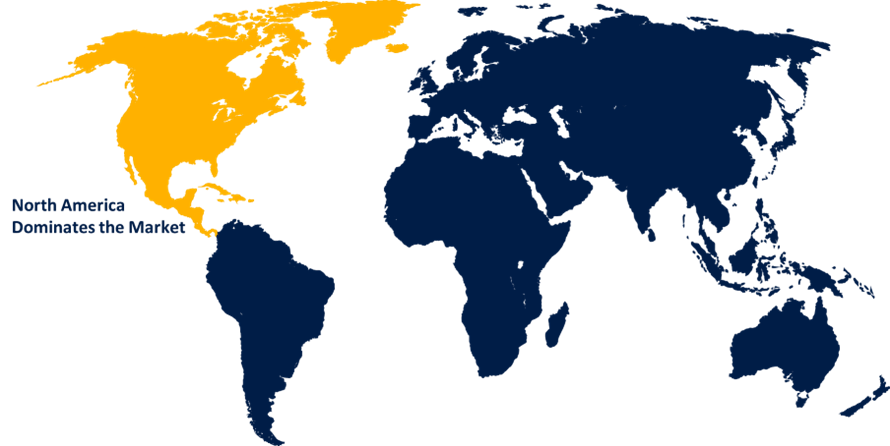Global Automotive Air Purifier Market Size, Share, and COVID-19 Impact Analysis, By Type (Purifier, Ionizer, Hybrid), By Technology (HEPA, Activated Carbon, Photocatalytic, Ionic Filter), and By Region (North America, Europe, Asia-Pacific, Latin America, Middle East, and Africa), Analysis and Forecast 2023 - 2033.
Industry: Automotive & TransportationGlobal Automotive Air Purifier Market Insights Forecasts To 2033
- The Global Automotive Air Purifier Market Size was valued at USD 1.8 Billion in 2023.
- The Market Size is Growing at a CAGR of 9.60% from 2023 to 2033.
- The Worldwide Automotive Air Purifier Market Size is Expected to reach USD 4.5 Billion by 2033.
- Asia Pacific is Expected to Grow the fastest during the forecast period.

Get more details on this report -
The global Automotive Air Purifier Market is Expected to reach USD 4.5 Billion by 2033, at a CAGR of 9.60% during the forecast period 2023 to 2033.
The automotive air purifier market is witnessing notable growth due to rising concerns over in-cabin air quality and increasing levels of air pollution. Consumers are becoming more health-conscious, leading to a greater demand for clean and safe air inside vehicles. Technological advancements such as HEPA filters, activated carbon filters, and ionizers are enhancing product efficiency and boosting adoption. The market is further driven by urbanization and growing awareness of the harmful effects of pollutants and allergens. Asia-Pacific dominates the market, particularly in countries with high pollution levels and rapid vehicle sales. Additionally, the COVID-19 pandemic has heightened the need for hygienic in-car environments, pushing automakers to integrate purification systems in new models. Despite challenges like high costs and limited awareness in certain regions, the market is expected to grow steadily.
Automotive Air Purifier Market Value Chain Analysis
The automotive air purifier market value chain involves several interconnected stages, beginning with raw material suppliers who provide essential components like filters, sensors, and plastic casings. Manufacturers then design and assemble the purifiers, integrating advanced technologies such as HEPA filters, activated carbon, and ionizers. These finished products are distributed through various channels, including OEMs (original equipment manufacturers), aftermarket retailers, and online platforms. Marketing and branding efforts play a vital role in consumer awareness and product positioning. Logistics and supply chain partners ensure efficient movement and availability of products across regions. End-users, including individual consumers and fleet operators, drive demand based on factors like pollution levels and health concerns. Feedback from users and technological developments continuously influence product innovation, closing the loop in the value chain through upgrades and new offerings.
Automotive Air Purifier Market Opportunity Analysis
The automotive air purifier market presents robust opportunities driven by escalating urban pollution, heightened health consciousness, and technological advancements. Emerging economies, notably in Asia-Pacific, are witnessing increased demand due to rapid urbanization and deteriorating air quality. In India, for instance, the market is projected to grow significantly, reflecting rising consumer awareness and the need for cleaner in-car environments citeturn0search0. Technological innovations, such as hybrid purifiers combining HEPA filters, activated carbon, and ionizers, are gaining traction for their enhanced efficacy citeturn0search10. Additionally, the integration of smart features like IoT connectivity and real-time air quality monitoring offers manufacturers avenues to cater to tech-savvy consumers citeturn0search5. The growing popularity of electric vehicles also presents a conducive platform for incorporating advanced air purification systems. Overall, the market is poised for substantial growth, offering diverse opportunities for innovation and expansion.
Market Dynamics
Automotive Air Purifier Market Dynamics
Growth in urban expansion and mounting vehicle congestion
The automotive air purifier market is experiencing steady growth, influenced by factors such as urban expansion and mounting vehicle congestion. As cities grow and more vehicles hit the roads, air quality inside vehicles is becoming a major concern for commuters. Increased exposure to pollutants, allergens, and harmful particles has driven demand for effective in-car air purification solutions. Health-conscious consumers are seeking advanced technologies like HEPA filters and ionizers to ensure cleaner cabin environments. Automakers are responding by integrating air purifiers into their vehicle offerings, especially in mid to high-end segments. Additionally, rising awareness about respiratory health, especially post-pandemic, has further fueled adoption. The trend is especially strong in emerging markets where urbanization is rapid. This growing need for clean, safe in-car air is shaping the future of the automotive air purifier industry.
Global Automotive Air Purifier Market Report Coverage
| Report Coverage | Details |
|---|---|
| Base Year: | 2023 |
| Market Size in 2023: | USD 1.8 Billion |
| Forecast Period: | 2023 - 2033 |
| Forecast Period CAGR 2023 - 2033 : | 9.60% |
| 2033 Value Projection: | USD 4.5 Billion |
| Historical Data for: | 2019 - 2022 |
| No. of Pages: | 240 |
| Tables, Charts & Figures: | 100 |
| Segments covered: | By Type, By Technology and By Region |
| Companies covered:: | 3M Company, Denso Corporation, Eureka Forbes, Honeywell International Inc., Koninklijke Philips N.V., Panasonic Corporation, Sharp Corporation, MAHLE GmbH, Xiaomi, Blueair, Ansio India Private Limited, Eco Technologies Pvt Ltd, Coway Co., Dometic Group AB, LG Electronics Inc., and Samsung Electronics Co. |
| Pitfalls & Challenges: | COVID-19 Empact, Challenge, Future, Growth, & Analysis. |
Get more details on this report -
Restraints & Challenges
High initial costs, including purchase and installation, deter price-sensitive consumers, particularly in emerging markets. Ongoing maintenance expenses, such as regular filter replacements, further add to the total cost of ownership. Integrating air purifiers into compact vehicle designs presents technical difficulties due to space constraints and compatibility with existing ventilation systems. Additionally, the presence of built-in air filters in standard vehicle air conditioning systems reduces the perceived need for separate purifiers. Limited consumer awareness about the benefits of automotive air purifiers, especially in regions with lower pollution levels, hampers market penetration. Economic fluctuations also impact consumer spending on non-essential automotive accessories, affecting market demand. Furthermore, the lack of standardized certifications and varying product quality can lead to consumer skepticism, hindering widespread adoption.
Regional Forecasts
North America Market Statistics

Get more details on this report -
North America is anticipated to dominate the Automotive Air Purifier Market from 2023 to 2033. Consumers are becoming more health-conscious, prompting a demand for cleaner vehicle interiors, especially in densely populated urban areas with high traffic congestion. Advancements in air purification technologies, such as HEPA filters and activated carbon systems, are further supporting market growth. The integration of air purifiers into vehicles, particularly in premium and mid-range models, is becoming more common as automakers respond to changing consumer preferences. Additionally, awareness campaigns and marketing strategies by manufacturers are boosting product visibility. While the United States leads the market, countries like Mexico are also witnessing growing interest. Overall, the North American region is poised for continued growth, influenced by lifestyle shifts and a stronger focus on health and wellness.
Asia Pacific is witnessing the fastest market growth between 2023 to 2033.
The Asia-Pacific automotive air purifier market is experiencing rapid growth, driven by increasing urbanization, high levels of vehicular pollution, and growing health awareness among consumers. Countries like India, China, Japan, and South Korea are witnessing a surge in demand for in-vehicle air purification systems due to deteriorating air quality and the need for cleaner cabin environments. Technological advancements, particularly in HEPA and activated carbon filters, are enhancing product efficiency and consumer adoption. The market is also benefiting from the integration of air purifiers in new vehicle models and the expansion of aftermarket sales channels. Additionally, the rise of electric vehicles presents new opportunities for incorporating advanced air purification technologies.
Segmentation Analysis
Insights by Type
The hybrid segment accounted for the largest market share over the forecast period 2023 to 2033. Hybrid purifiers combine multiple filtration technologies, such as HEPA filters, activated carbon, and ionizers, to effectively remove a wide range of airborne contaminants, including particulate matter, volatile organic compounds (VOCs), odors, bacteria, and viruses. This comprehensive approach offers superior air purification compared to single-technology systems, making them particularly appealing to consumers seeking a holistic solution for in-car air quality. As urbanization and industrialization continue to rise, the demand for efficient and compact air purification systems in vehicles is growing.
Insights by Technology
The HEPA segment accounted for the largest market share over the forecast period 2023 to 2033. HEPA filters are highly effective at trapping up to 99.97% of airborne particles as small as 0.3 microns, including dust, pollen, pet dander, bacteria, and viruses. This efficiency makes them particularly appealing to individuals with allergies or respiratory sensitivities, addressing rising health concerns. As a result, HEPA-equipped air purifiers are increasingly integrated into both luxury and mid-range vehicles to enhance in-cabin air quality. The growing adoption of HEPA filters aligns with the broader trend of consumers seeking healthier, more comfortable driving environments, positioning HEPA technology as a dominant force in the automotive air purifier market.
Recent Market Developments
- In January 2023, Panasonic Automotive Systems Company of America introduced the nanoe X portable air cleaner for vehicles at CES 2023.
Competitive Landscape
Major players in the market
- 3M Company
- Denso Corporation
- Eureka Forbes
- Honeywell International Inc.
- Koninklijke Philips N.V.
- Panasonic Corporation
- Sharp Corporation
- MAHLE GmbH
- Xiaomi
- Blueair
- Ansio India Private Limited
- Eco Technologies Pvt Ltd
- Coway Co.
- Dometic Group AB
- LG Electronics Inc.
- Samsung Electronics Co.
Market Segmentation
This study forecasts revenue at global, regional, and country levels from 2023 to 2033.
Automotive Air Purifier Market, Type Analysis
- Purifier
- Ionizer
- Hybrid
Automotive Air Purifier Market, Technology Analysis
- HEPA
- Activated Carbon
- Photocatalytic
- Ionic Filter
Automotive Air Purifier Market, Regional Analysis
- North America
- US
- Canada
- Mexico
- Europe
- Germany
- Uk
- France
- Italy
- Spain
- Russia
- Rest of Europe
- Asia Pacific
- China
- Japan
- India
- South Korea
- Australia
- Rest of Asia Pacific
- South America
- Brazil
- Argentina
- Rest of South America
- Middle East & Africa
- UAE
- Saudi Arabia
- Qatar
- South Africa
- Rest of the Middle East & Africa
Frequently Asked Questions (FAQ)
-
1.What is the market size of the Automotive Air Purifier Market?The global Automotive Air Purifier Market is expected to grow from USD 1.8 billion in 2023 to USD 4.5 billion by 2033, at a CAGR of 9.60% during the forecast period 2023-2033.
-
2.Who are the key market players of the Automotive Air Purifier Market?Some of the key market players of the market are 3M Company, Denso Corporation, Eureka Forbes, Honeywell International Inc., Koninklijke Philips N.V., Panasonic Corporation, Sharp Corporation, MAHLE GmbH, Xiaomi, Blueair, Ansio India Private Limited, Eco Technologies Pvt Ltd, Coway Co., Dometic Group AB, LG Electronics Inc., Samsung Electronics Co.
-
3.Which segment holds the largest market share?The HEPA segment holds the largest market share and is going to continue its dominance.
Need help to buy this report?